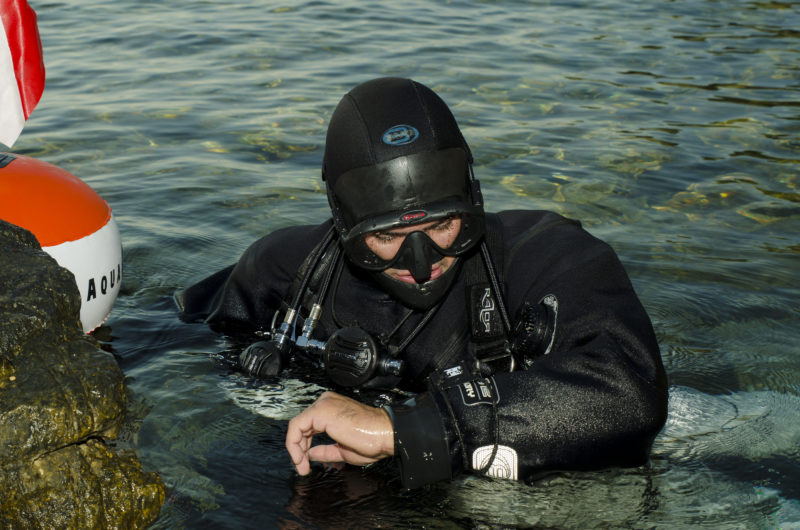The right computer is a key part of any tech diver’s equipment. And while most people starting their tech diving journey already have a dive computer, their requirements are likely to change once they start doing deeper, more-complex dives. Here’s our take on what to look for when choosing a computer for technical diving.
What makes it a computer for technical diving?
Manufacturers advertise plenty of recreational dive computers as tech computers. These models allow users to switch between multiple gases on a dive, program trimix gases and even back-up CCR diving. But what really makes a dive computer suitable for technical dives? As with most other technical diving equipment, it’s less about looks and more about substance.
Put simply, it’s what’s on the inside that counts. And in the case of tech diving computers, the key ingredient is the algorithm the machines base their predicted dive profiles on. Few recreational divers worry about how their computer determines how much no-stop time they have left. Often manufacturers simply set computers to be more-or-less conservative.
Technical divers, on the other hand, plan their dives meticulously. This includes predictions of how much gas they will need based on bottom time and required decompression stops. Tech divers usually plan on desktop software pre- dive, so using compatible algorithms in the planning stage and on the dive computer itself ensures that predictions match.
Currently, the most commonly used algorithms in both desktop and dive-computer software are Buhlmann ZHL16 with gradient factors (GF) and VPM. Tech divers and instructors use both successfully worldwide. Their source code is freely available to software developers. which makes their dive-profile results more predictable.
Personalization

Leading tech dive computers offer divers a high degree of personalization. This starts with the ability to adjust the degree of conservatism applied to their dive via gradient factors (ZHL) and conservatism settings (VPM). In many cases, divers can adjust these on the dive, allowing adaptation to changing conditions while underwater.
A good tech computer will also allow its user to change the display and prioritize certain pieces of information over others. This allows the diver to see a lot of information at one time or reduce it to the bare minimum.
Technical dives often involve darker environments. In those circumstances, having a computer with a bright, clear display that you can read without a torch can make all the difference.
Gas-programming capabilities
One obvious characteristic of any tech diving computer is the capability to program more than one gas per dive. Serious tech diving computers allow users to program five gases — some offer even more. They also have an easy protocol for switching from one to the other. While recreational divers generally only change the oxygen content of their gas on their computer, tech divers may also want to adjust the oxygen partial pressure they are exposed to on a dive.
A number of the leading brands also allow divers to program new gases while already on the dive. This can be useful when a team dives different gases and a diver must use a teammate’s tank in an emergency.
Accounting for diver error
We must also consider how a dive computer deals with diver error. While tech divers are highly skilled when it comes to buoyancy skills, for example, there may be circumstances when they miss a decompression stop or ascend shallower than their computer dictates. A serious tech diving computer will recalculate and offer an alternative decompression schedule. What would be downright dangerous is a computer that locks you out while still underwater.
Practically speaking, it’s worth considering what happens if you have a problem with your computer. Research the manufacturer’s after-sales service policy. A quick Google search will soon show whether the company is easy to deal with or hard to reach.
If you live or dive remotely, consider which batteries your computer uses and whether you can change them. One of the leading brands runs on AA batteries, making life very simple for divers since these batteries are available pretty much anywhere in the world.
Backing up your computer
Now that you’ve found your perfect tech diving computer, it’s time to consider what you’ll use for a backup — ideally another computer of the same kind. Advantages of this setup include familiarity with the menu and the computer’s settings and diving off similar profiles. However, if — like many new technical divers — you need to build up your equipment gradually and buy new gear in stages, your recreational computer in gauge mode or even a combined depth gauge and timer would work as a back-up initially. In this case, be sure to carry a copy of your dive plan on a slate or a wet notebook.
As with most major dive-gear purchases, it pays to do your research before shopping. If you’re not a qualified tech diver yet ask your instructor what they recommend and why. Think about where you want your diving to take you and make sure you choose a dive computer that can follow you there.

